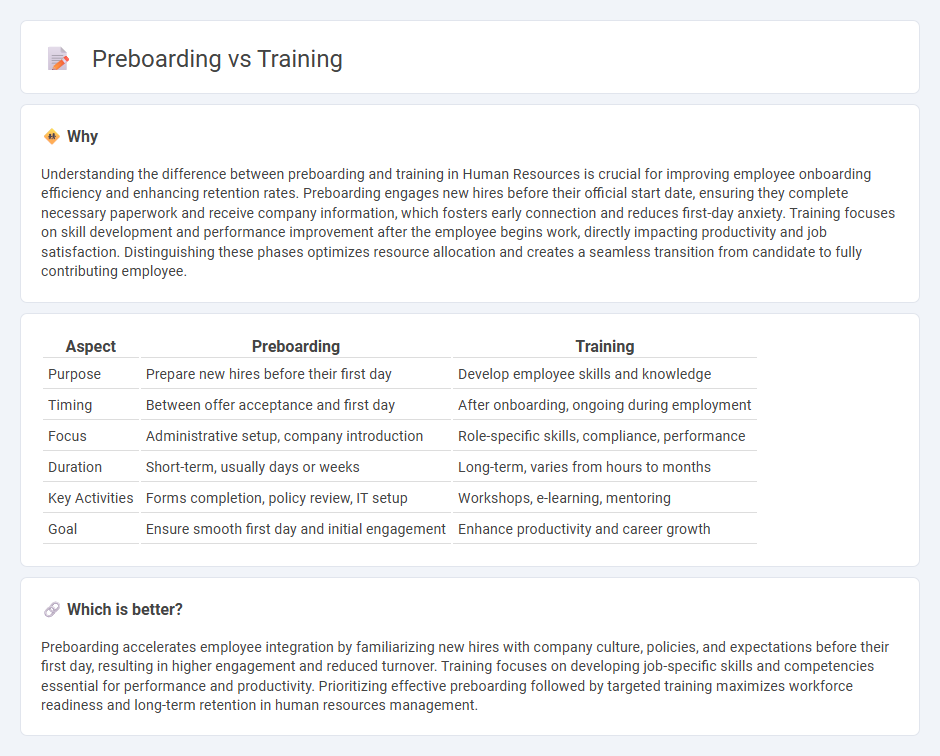
Preboarding involves engaging new hires before their official start date to streamline onboarding processes and boost early productivity. Training focuses on developing employees' skills and knowledge to enhance job performance and career growth. Explore how effective preboarding and training strategies can transform your workforce development.
Why it is important
Understanding the difference between preboarding and training in Human Resources is crucial for improving employee onboarding efficiency and enhancing retention rates. Preboarding engages new hires before their official start date, ensuring they complete necessary paperwork and receive company information, which fosters early connection and reduces first-day anxiety. Training focuses on skill development and performance improvement after the employee begins work, directly impacting productivity and job satisfaction. Distinguishing these phases optimizes resource allocation and creates a seamless transition from candidate to fully contributing employee.
Comparison Table
| Aspect | Preboarding | Training |
|---|---|---|
| Purpose | Prepare new hires before their first day | Develop employee skills and knowledge |
| Timing | Between offer acceptance and first day | After onboarding, ongoing during employment |
| Focus | Administrative setup, company introduction | Role-specific skills, compliance, performance |
| Duration | Short-term, usually days or weeks | Long-term, varies from hours to months |
| Key Activities | Forms completion, policy review, IT setup | Workshops, e-learning, mentoring |
| Goal | Ensure smooth first day and initial engagement | Enhance productivity and career growth |
Which is better?
Preboarding accelerates employee integration by familiarizing new hires with company culture, policies, and expectations before their first day, resulting in higher engagement and reduced turnover. Training focuses on developing job-specific skills and competencies essential for performance and productivity. Prioritizing effective preboarding followed by targeted training maximizes workforce readiness and long-term retention in human resources management.
Connection
Preboarding sets the foundation for effective training by familiarizing new hires with company culture, policies, and expectations, which accelerates their engagement and learning curve. Early exposure to essential information during preboarding reduces onboarding time and enhances the retention of training content. This seamless transition from preboarding to formal training boosts employee productivity and satisfaction in Human Resources management.
Key Terms
Onboarding
Training and preboarding serve distinct roles within the onboarding process; preboarding prepares new hires by sharing essential company information and setting expectations before their start date, while training focuses on developing specific job skills and knowledge after onboarding begins. Effective onboarding integrates both preboarding and training to enhance employee engagement, reduce time-to-productivity, and improve retention rates. Explore comprehensive onboarding strategies to optimize workforce integration and performance.
Skill Development
Training centers on enhancing specific job skills and competencies necessary for current roles, fostering employee performance and productivity. Preboarding introduces new hires to company culture, tools, and expectations, laying the groundwork for effective onboarding and early engagement. Discover how integrating targeted training and strategic preboarding can accelerate skill development and employee success.
Orientation
Orientation in preboarding introduces new hires to company culture, policies, and expectations before their official start date, fostering early engagement. Training begins after onboarding, emphasizing skill development and job-specific competencies critical for performance. Explore how effective orientation during preboarding enhances employee retention and productivity.
Source and External Links
Training - Wikipedia - Training is the process of teaching or developing skills and knowledge relating to specific competencies to improve capability, productivity, and performance, including ongoing professional development and physical fitness related to specific activities.
360training(r) | Regulatory Compliance Training Online - 360training offers over 7,000 regulatory, compliance, and job-specific online training courses with certifications accessible 24/7, helping learners meet career and regulatory requirements efficiently.
TRAINING | definition in the Cambridge English Dictionary - Training is the process of learning the skills you need to perform a particular job or activity, or preparing yourself physically for a competition or role, through exercises and instruction.
 dowidth.com
dowidth.com